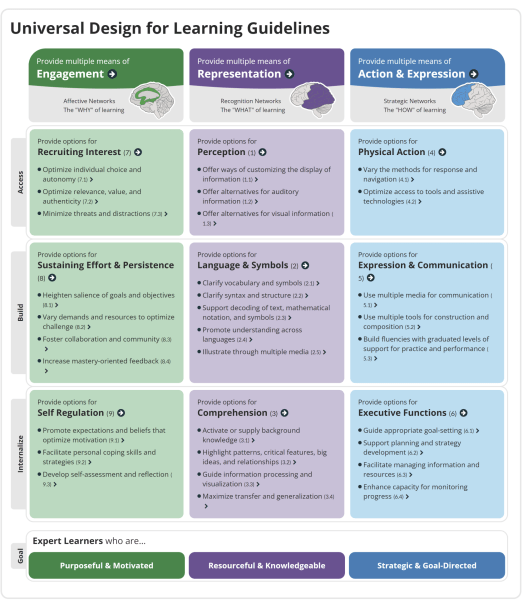What is UDL?
UDL, or Universal Design for Learning, is a framework for teaching and learning that aims to provide access to all students, regardless of their background, socio-economic status, or learning styles. According to the Center for Applied Special Technology (CAST) it is based on the principles of universal design, which originated in architecture and engineering to create environments that are accessible to everyone, including individuals with disabilities (CAST, 2024). For example, the Americans with Disabilities Act (ADA) led to the creation of ramps for people with limited mobility. However, the ramps were not just used for those with wheelchair users; they also helped delivery couriers, people with strollers, and others with limited mobility, whether permanent or temporary. A corollary in instructional design is including captions on videos. It not only helps those with hearing impairments but also non-native speakers, people viewing in distracting environments, and those who are just starting their journey and learning to read.
One of the many principles that UDL highlights is that every student deserves equal opportunities to learn. By slowly implementing the principles of UDL, faculty are able to recognize opportunities where learners have diverse needs, preferences, and strengths, and then address these variabilities by providing multiple means of representation, expression, and engagement. This does not need to be done all at once. In fact, slowly implementing new teaching strategies in an iterative process will allow faculty to correct any smaller problems that may come up and improve the quality of the course for all. To help guide this process the Center for Applied Special Technology (CAST), highlights three main principles that form the core of UDL:
- Multiple Means of Representation: This principle emphasizes presenting information and content in various formats, such as text, audio, video, graphics, and hands-on experiences. By offering information in multiple ways, educators can accommodate diverse learning styles and preferences, making the content more accessible to all learners.
- Multiple Means of Expression: UDL encourages you to provide students with various options for demonstrating their knowledge and understanding. These can include written assignments, oral presentations, multimedia projects, artistic creations, and more. By offering multiple means of expression, educators can allow students to choose the method that aligns best with their strengths and preferences.
- Multiple Means of Engagement: This principle focuses on providing students with different ways to engage with the learning process and maintain their interest and motivation. Strategies may include incorporating interactive activities, real-world applications, collaborative projects, and opportunities for self-assessment and reflection. By offering diverse ways to engage with the material, you can support learners with varying interests, backgrounds, and levels of motivation.

These principles can be applied individually or all at once depending on the comfort level of the faculty. Also it’s important to note that they can be applied at an task level, assignment level, or across the whole course. For more detailed information about these principles, please explore UDL Guidelines by CAST.
Why is UDL important for faculty?
Faculty can leverage UDL to create inclusive learning environments that accommodate the diverse needs of all students and ensure that all students have equitable access to the curriculum and learning materials. By providing multiple means of representation, expression, and engagement, you can support your students’ diverse learning abilities. By offering choices and opportunities for active learning, you can create a more dynamic and engaging learning environment that promotes deeper understanding and retention of the material. Last but certainly not least, UDL may help ensure compliance with accessibility standards such as the Americans with Disabilities Act (ADA) and the Web Content Accessibility Guidelines (WCAG). Currently the University uses WCAG 2.1, Level AA. By designing courses with accessibility in mind from the outset, you can minimize the need for retroactive accommodations and create a more inclusive learning environment for all students. This will save you time, energy and stress when accommodation needs arise.
Is UDL just about catering to students?
No, Universal Design for Learning is not about appeasing students or making academics less rigorous for students. It is about creating an inclusive learning environment that supports the diverse needs of all learners. Traditional, one-size-fits-all approaches to teaching may not effectively support all learners. By providing multiple means of representation, expression, and engagement, UDL allows you to address the individual needs of their students and create learning experiences that are accessible, engaging, and effective for everyone.
Also, UDL is rooted in principles of equity and access, acknowledging that all students have the right to an education and empowers them to reach their full potential. By implementing UDL principles, you can foster a more inclusive and supportive learning environment that benefits all students, not just those with specific accommodations or preferences.
If you are interested in learning more or have questions about implementing UDL the Learning Design Team is dedicated to helping you with the efficient and effective use of digital technologies to advance teaching and learning across multiple modalities. Please feel free to reach out to us
Further Resources:
- Review Academic Technology Solutions’ full list of Teaching Tools.
- Learn about Universal Design for Learning from CAST.
- Explore the University of Chicago’s Center for Digital Accessibility.
- Request an instructional design consultation with LDT instructional designers.
- Request digital media consultation and development services in support of teaching materials and the presentation of research.
- Request custom workshops for departments or programs who want to tailor the content to their instructors or subject area.
- Join us in office hours, virtual or hybrid, during which you can ask any questions you may have.
- Join our online workshops on various topics related to teaching with technology.

